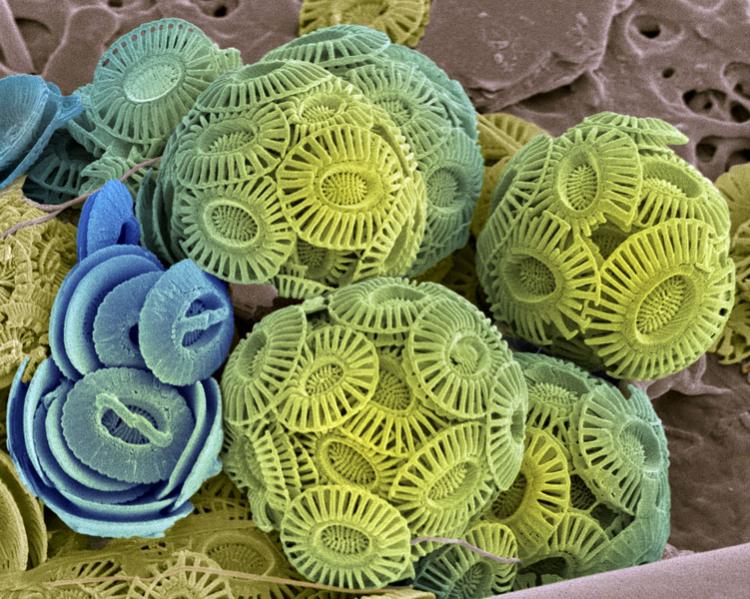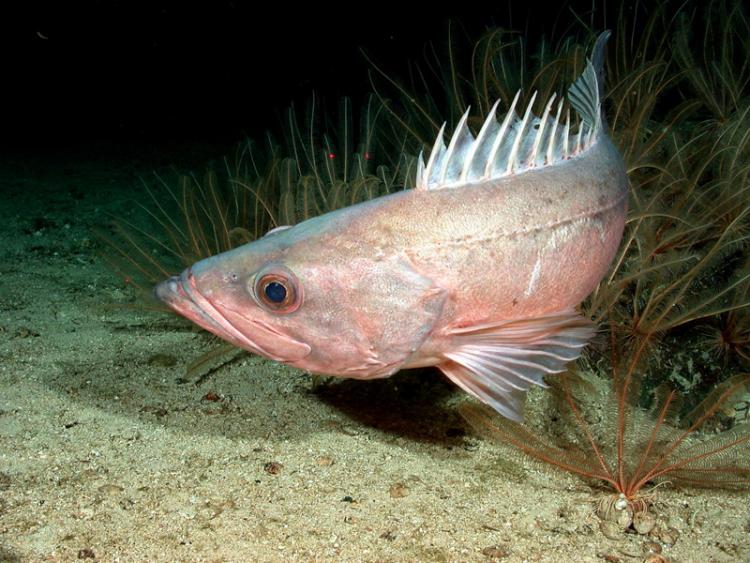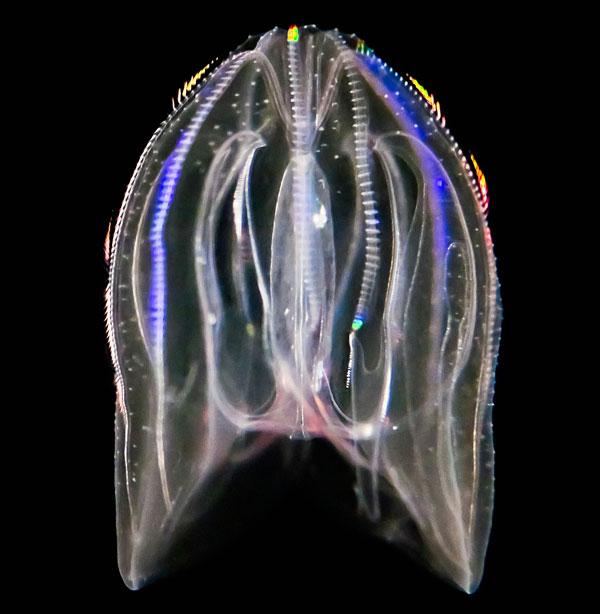A multitude of marine species, from bottom-dwellers to fish and octopuses, are gasping for air. In swaths of ocean the world over, creatures are being increasingly deprived of oxygen. It’s a hidden consequence of climate change, less obvious than rising seas and mass coral-bleaching events — yet no less dangerous to marine life.
Oxygen levels vary in oceans around the world, but signs of global warming–driven declines have begun to emerge beyond those natural fluctuations, and conditions in coastal areas exposed to agricultural runoff, such as the Gulf of Mexico and the East Coast’s Chesapeake Bay, are worsening. The declines are wreaking ecological change that won’t be reversed for centuries, if at all, climate scientists warn.
The very existence of some species is at stake, according to research led by Lisa Levin, a biological oceanographer at the Scripps Institution of Oceanography in La Jolla, California, who is known for her studies of deep-sea ecosystems and oxygen-deficient ocean waters. “Climate change and warming are making naturally occurring, low-oxygen areas bigger than they were,” Levin says. “They’re exacerbating coastal nutrient-driven ‘dead zones,’ making them occur in more places, start earlier in the summer, and last longer.”
Over the past half-century, the open ocean has lost about 2 percent of its oxygen on average, but some areas — such as the north and east Pacific Ocean, tropical waters and the Southern Ocean — have experienced more precipitous declines. Most other oceans face similar drops within the next 15 to 25 years, according to climate projections that were modeled assuming that carbon emissions would continue to be business as usual.
Ocean-dwelling phytoplankton (also known as microalgae) and other plants add oxygen into the water during photosynthesis. But as temperatures rise, especially in the upper ocean, less oxygen can dissolve in the seawater. Warming also slows down the ventilation of the waters by winds and currents, which would normally stir in oxygen. Less mixing leads the water to become more stratified, causing an isolated, oxygen-deficient zone to develop at depths of 100 meters to 1 kilometer.
Warming also increases the respiration rates of microbes and animals, so they use up more oxygen than they would at lower temperatures just to meet their bodies’ metabolic demands. Phytoplankton, which both produce and respire oxygen, grow more vigorously in warmer waters, then die off, decay and sink to the bottom, where bacteria feed on them and suck up yet more oxygen in the process.

Marine phytoplankton, such as these tiny coccolithophores (shown here in false color under a scanning electron microscope) add oxygen to the upper levels of the ocean. But an increase in their numbers can reduce the already-limited oxygen supply in deeper water. As they die and sink to the ocean floor, they fuel the activity of oxygen-consuming decomposers.
Credit: Steve Gschmeissner/Science Source
Ecological effects
To make matters worse, runoffs from rivers and estuaries along major coastal areas carry nutrients from agricultural waste and inadequately treated human sewage. Nitrates from fertilizers, for example, leach into groundwater, make it out to sea and spur dense growths of algae, known as algal blooms. These blooms gobble up much more oxygen than normal, giving rise to dead zones.
“Things aren’t really dead there — there are little animals that can tolerate it,” Levin says. She and her colleagues found that many microbes, tiny worms and even some fish and sea urchins can survive in these harsh, nearly oxygen-free conditions. But most other wildlife has to move or die.
Animals living on the ocean bottom are especially susceptible, says Denise Breitburg, a marine scientist at the Smithsonian Environmental Research Center in Edgewater, Maryland, who studies marine ecosystems and the effects of oxygen loss. And even though fish tend to relocate to spots outside the most severely depleted areas, they still can suffer. “Some end up being exposed to chronic low oxygen, reducing their populations, too,” Breitburg says.
Harm can be more subtle than outright death. For some marine animals, sparse oxygen can damage vision, for example, by increasing the likelihood of diseases associated with the eye, according to new research by Levin and her team. The scientists now want to know whether this inhibits finding mates for reproduction or makes creatures more vulnerable to starvation or predation. If octopuses or squid, for example, now need more light, they might move to new spots with less food, or more predators.
These oxygen-starved regions are expanding, and they’re pushing the intolerant species up into shallower water, Levin says. But there’s a limit to how shallow they can go — oceans have a surface, after all. This creates a phenomenon known as “habitat compression.”
Consider the rockfish. Many species live off the coast of Southern California as well as in the northern Pacific, at depths as low as 1,500 meters. But they’re not tolerant of the low oxygen increasingly found there. As they lose habitat areas, they end up aggregating in shallower, better-lit waters, where they’re more easily targeted by commercial fishers, Levin and her colleagues have found. Rockfish are now overfished.

An adult rockfish of the bocaccio species swims along the seafloor off the California coast, an area with a growing number of low-oxygen zones.
Credit: Advanced Survey Technologies/Fisheries Resources Division/SWFSC
Omens from the past
Rockfish are just one of many interconnected species in many oceans around the world that stand to be affected as oxygen-deficient zones persist and grow. Entire ecosystems could be transformed, becoming less habitable than the driest deserts. “Levin’s really tying this to the biological record and what this might mean for the future, such as whether we are heading to a sixth mass extinction,” says Jeremy Owens, a marine geologist at Florida State University in Tallahassee.
Owens’s own work examines fossils in the geological record, and waves of past extinctions, some of which may parallel what’s happening in the ocean today and offer clues to where ocean life may be heading. In a minor extinction event some 94 million years ago, for example, widespread volcanic activity increased carbon dioxide levels in the atmosphere, raised surface temperatures and sea levels, and trapped extra nutrients in ocean waters. Evidence also points to a rapid oxygen loss in that ancient climatic event that likely played a role in the extinctions (including the demise of the ichthyosaurs and more than a quarter of marine invertebrates).
Similarly, some scientists think that the even more dramatic Permian-Triassic extinction event of about 252 million years ago — in which more than 90 percent of marine species perished — followed a similar pattern, with ocean oxygen depletion partly to blame. Today’s situation is not as extreme: Carbon dioxide emissions would have to continue at the current level for more than a century before ocean oxygen loss reached a similar level, says Matthew Long, a climate scientist at the National Center for Atmospheric Research in Boulder, Colorado.
Still, Long is already concerned. “It’s amazing to me how life evolved on Earth in this co-dependent way: Microorganisms invented photosynthesis that resulted in the production of oxygen, and suddenly that created this intricate network of life,” he says. “Then I imagine what we’re doing through human-driven warming — changing oxygen, an important control on the metabolism of animals. Seventy percent of the planet is being changed in invisible ways that will have profound impacts on marine ecosystems.”
What can be done
Just as humans have the power to wreak havoc with marine life, they also have the power to alleviate these problems. The world’s oceans have seen warming, acidification, sea-level rise and depleted oxygen — but reducing greenhouse gas emissions would address them all in one fell swoop, Levin says. For nutrient-driven oxygen loss closer to shore, Breitburg argues that people could develop agricultural practices that minimize nutrient runoff; treat sewage and wastewater before it reaches the ocean; and better regulate power-plant emissions, which include airborne nitrogen that contributes to the formation of dead zones.

Jellyfish and jellyfish-like comb jellies, such as this Mnemiopsis leidyi, are some of the few kinds of marine wildlife that can tolerate low oxygen levels. Their growing populations can further diminish oxygen in deeper waters.
Credit: WaterFrame / Alamy Stock Photo
But since oxygen-limited oceans will persist for decades or more even if all the right things are done, Levin calls for more work on adaptation — incorporating the effects of climate change into environmental management. People could manage fish in a way that considers particularly vulnerable species, such as rockfish. This might, she says, mean setting aside protected marine areas or adding species that are intolerant of low oxygen to no-fishing lists.
“I try to advocate for climate-tolerant fisheries. Take the species you know can handle climate change, and stop fishing and buying the ones that can’t,” Levin says. “Scientists need to figure out which is which.”
Editor's note: This article was updated May 30, 2018, to correct an error about types of fish vulnerable to low oxygen levels in seawater. Rockfish are indeed particularly vulnerable; black cod and Dover sole, mentioned erroneously in the original version of this article, are in fact highly tolerant.




